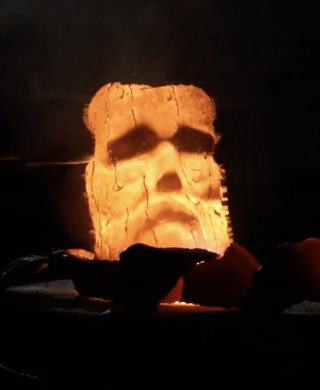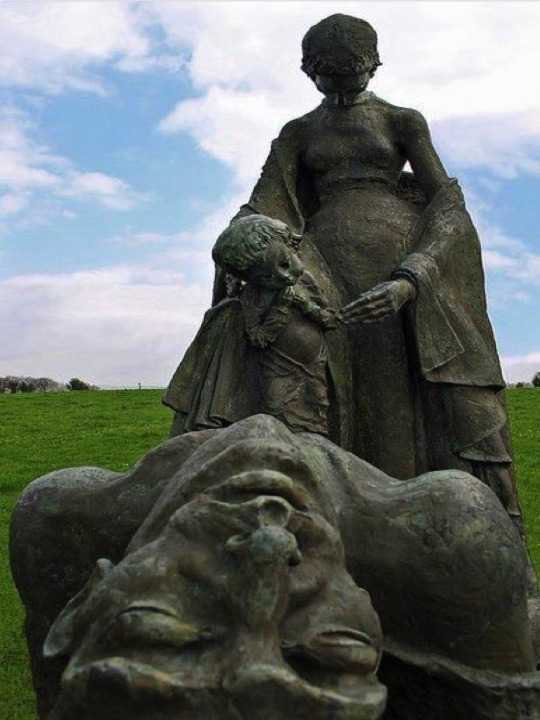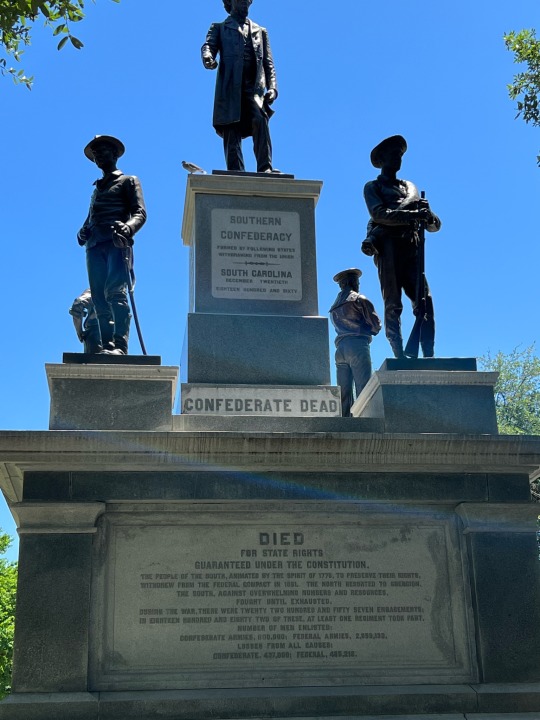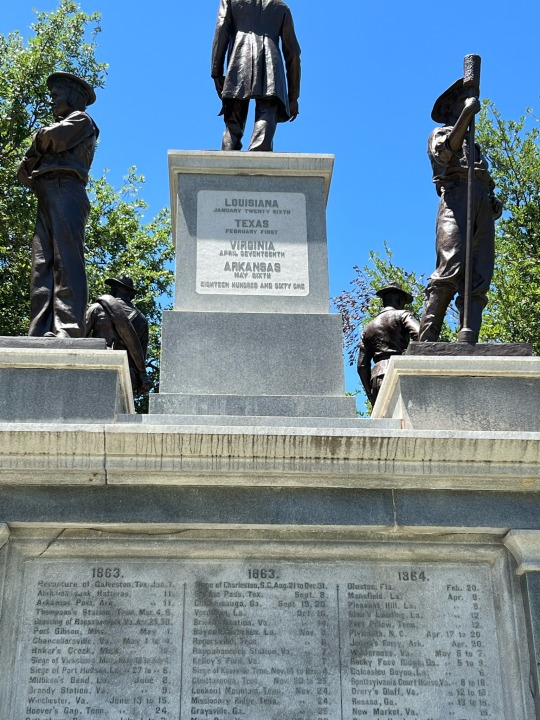#Civil War Monument
Explore tagged Tumblr posts
Text





The Civil War Monument. One of the most beautiful memorials I've ever seen.
Bushnell Park
Hartford CT 4/15/23
10 notes
·
View notes
Text
if you ever wonder whether humans actually love and care about each other just remember that the guards at the tomb of the unknown soldier in arlington wear special fatigues with no insignia so they do not outrank the unknowns interred or commemorated there
#the tomb of the unknown soldier is like a tangible representation of people caring about strangers#but this detail really makes me hopeful#like for it to be so important that we respect and honor the memories of those who have no one to remember them makes me cry#for context:#the tomb of the unknown soldier is both a literal tomb and a monument to fallen soldiers whose remains could not be identified#a lot of countries have one and the US has multiple#the one in arlington cemetary is the main US one#its the final resting place of three US soldiers#one from WWI one from WWII and one from the korean war#the other ones are monuments to unknowns from older wars#mostly the civil war#because so many people died and IDing bodies was much harder back then
13 notes
·
View notes
Text



Civil War (2024)
#2024#gif#film#movie#military#Civil War#Alex Garland#Kirsten Dunst#Lee Smith#Cailee Spaeny#Jessie#Wagner Moura#Joel#Stephen McKinley Henderson#Sammy#Nick Offerman#President#Second American Civil War#Western Forces#Washington Monument#White House#Washington DC#Colt#Mk 18#Mod 0#M4A1#M224#Remington#M24
11 notes
·
View notes
Text

























American Civil War: Florida seceded from the Union on January 10, 1861.
#American Civil War#Florida#seceded#USA#10 January 1861#anniversary#US history#Castillo de San Marcos National Monument#landscape#cityscape#Everglades National Park#Gulf of Mexico#original photography#Green Cay Wetlands and Nature Center#nature#architecture#2010#summer 2016#vacation#Cruger-dePeyster Sugar Mill#American Alligator#Bulow Creek State Park#Fairchild Oak#Daytona Beach#Atlantic Ocean#Old Florida State Capitol#travel#tourist attraction#Tallahassee
7 notes
·
View notes
Text
"Confederate monuments bear what the anthropological theorist Michael Taussig would call a public secret: something that is privately known but collectively denied. It does no good to simply reveal the secret — in this case, to tell people that most of the Confederate monuments were erected not at the end of the Civil War, to honor those who fought, but at the height of Jim Crow, to entrench a system of racial hierarchy. That’s already part of their appeal. Dr. Taussig has argued that public secrets don’t lose their power unless they are transformed in a manner that does justice to the scale of the secret. He compares the process to desecration. How can you expect people to stop believing in their gods without providing some other way of making sense of this world and our future?
Swords Into Plowshares might have been the first to propose melting, but other communities are working out their own creative visions for Lee’s afterlife. One of the biggest changes so far has been at Arlington House, the historic plantation mansion at the center of Arlington National Cemetery, which is the official national Robert E. Lee Memorial. In 2021, Arlington House reopened with displays not only about Lee’s family, who lived there after they inherited it from Lee’s father-in-law, but also about the lives of the families enslaved there. Even Lee’s burial site at Washington and Lee University in Lexington, Va. — where he served as president after the war — has changed. The university decided to focus on Lee the civilian rather than Lee the general, for example by moving a prominent portrait of him in uniform. And it constructed a wall to enclose the large sculpture of Lee that once claimed an insistent place in the university’s chapel.
Covering this story over the past few years, I’ve come to realize two things. First, when a monument disappears without a ceremony to mark why it is coming down, a community has no chance to recognize that it has itself changed. (Ideally the ceremony is public, but because of safety concerns, the melting I attended was not.) Second, if you are outraged that something’s happening to your community’s heroic statue of Lee, you’re not going to be any less outraged if the statue is moved to some hidden storeroom than if it’s thrown into a landfill. So if all changes, large or small, will be resisted, why not go for the ones with the most symbolic resonance?
That’s why the idea to melt Lee down, as violent as it might initially seem, struck me as so apt. Confederate monuments went up with rich, emotional ceremonies that created historical memory and solidified group identity. The way we remove them should be just as emotional, striking and memorable. Instead of quietly tucking statues away, we can use monuments one final time to bind ourselves together into new communities.
...
When the remaining legal barriers were cleared (including a last-minute lawsuit that sought to have the statue reassembled), Lee was finally ready to surrender to the furnace. The foundryman turned on the propane supply and laid Lee’s sword across the hole in the lid. He told the spectators that the metal had to get hot enough to release any moisture before he maneuvered it down through the hole into the crucible.

When he did, its blade stuck up out of the furnace for a moment, then melted down “like a stick of butter,” as Dr. Schmidt put it.
Lee’s face was the last piece to go into the crucible. Given how often the monument and its ideals were celebrated with flames — from Klansmen’s torches to the tiki torches of white nationalists in 2017 — it seemed fitting for flames to close over the monument.
...
Dr. Douglas, Swords Into Plowshares’ other co-founder, apologized that the ceremony could not be public. She thanked those in attendance, telling us we were witnessing it on behalf of Charlottesville’s residents, including those long gone who lived under slavery. Someday, she said, when we think of Civil War heroes, we will imagine not Lee but, instead, those who fought for their freedom against him.
The man in the protective visor dropped the red-hot piece of metal that once represented Lee on the ground. It fell to pieces, which he fed into the crucible. A line of cameras faced him, making new images of history as the old image finally disappeared in flames.
- Erin Thompson, "The Most Controversial Statue in America Surrenders to the Furnace." New York Times. October 24, 2023. Photo by Eze Amos.
#swords into plougshares#confederate monuments#robert e. lee#tear them down#historical monuments#american civil war#historical memory#united states history#united states politics
18 notes
·
View notes
Text
#OTD in 1923 – Nine Republican prisoners are taken from Ballymullen Barracks in Tralee to Ballyseedy Cross, ostensibly to clear a mined road.
Kerry had seen more violence in the guerrilla phase of the Civil war than almost anywhere else in Ireland. By March 1923, sixty-eight Free State soldiers had already been killed in Kerry and 157 wounded. Eighty-five would die there by the end of the war. The day after Five Free State soldiers were killed by a booby trap bomb while searching a republican dug out at the village of Knocknagoshel,…

View On WordPress
#(Yann Goulet#Ballyseedy Massacre#Ballyseedy Monument#Co. Kerry#Free State Soldiers#Guerilla warfare#Ireland#Irish Civil War#Irish History#Knocknagashel#Land mines#Paddy Daly#Republicans#Sculpter)#Tralee
9 notes
·
View notes
Text

i NEED to go there
#trying to convince my parents to drive me to the uncertain site of the battle of pharsalus to look at the absence of monuments#lack of monumental commemoration of civil war conflict from my thesis…………#lucancore#beeps
47 notes
·
View notes
Note
Even 6 years after botw, and 3 months after totk's release, I have to admit: They're good games, though lacking in story, but they're honestly not good "Legend of Zelda games." Totk being less so than botw. It's not about the shrines, puzzles or temples, or lack of them; the games are just kinda missing that LoZ feeling. I think an anon had a good take: LoZ refers to Zelda's story from a historians perspective, but is actually the story of Link and his adventure for us players. Botw is missing that, and in totk that's completely gone, with everything focusing on Zelda.
Hey, thank you!
I think I try to stray away from what makes a good Zelda game (or a Zelda game altogether) because I think that there is nothing more Zelda-core than fighting about what makes the essence of Zelda, and everybody being convinced they're extremely right about it (not excluding myself AT ALL btw, it's just... for some reason it's impossible to talk about Zelda and what you care about in the series without taking it to weird absolutes and being semi-toxic about it, which ??? it's so strange that it's a nearly-universal thing, why is it such a thing) and it's ultimately very personal. Obviously they kind of lost me with TotK in terms of player values, but I completely relate to seeing this thing you love drifting away from you.
I think what I miss the most is the bittersweetness, this idea that for any act of bravery to become a legend, you have to part with something meaningful and let it rest behind. At the heart of every single one of your adventures, there is this sacrifice that you have to make: be it a relationship, a sense of innocence, a person, an entire world... I often hear that Zelda only cares for happy endings, and I don't think it's that true? Like of course things are good by the end, the baddie is dead or sealed away, you are triumphant, the world is no longer in disarray... But there's always a cost.
I think it's really the heart of why I failed to connect with TotK's themes at the end of the day, if I try to de-intellectualize and take it in a more emotional way (and then of course it resonates with all of the reasons why I'm bothered with depicting any kingdom as worth preserving as is, without questioning anything about it)
#asks#thoughts#totk#totk critical#tloz#when will my brain return from the imprisoning war...#thanks for the ask!!#yeah I can think of something we the player personally lose in any other game I've played#but totk it's... yeah...#I suppose the zonais count?#but even their civilization and monuments seem to be staying there when the game end? so it's not even a case of “the past fading away”#which would have been cool and also emotionally compelling#and thematically stronger#like “you have dealt with the past's weird hangups now go and make your own future”#but here it just... freezes everything in time#I suppose Rauru Sonia and Mineru count?? but like you have no relationship with them#it was zelda's loss not the player's#I guess you lose your arm?? but really you're just restoring what was before the game started#and it's portrayed as a good thing too not like parting with a strong newfound part of your identity you will learn to live without
27 notes
·
View notes
Text

6 notes
·
View notes
Text

Fort Pulaski Howitzer
Last of the three major types of artillery in use during the War of 1812 was the howitzer. It was used throughout the Civil War.
#military weapons#muttball#travel photography#photography#travel america#howitzer#fort pulaski#civil war#national monument#georgia
20 notes
·
View notes
Text





I was very impressed with my Southern Brethren in TX. God bless y’all this beautiful Texas day.

20 notes
·
View notes
Text
"We are literally living the history that might be hidden from our children in the future." That line hit me so hard I had to share this everywhere! A brief history of why history is taught how it is in the United States
#us history#slavery#education#racism#confederate monuments#states rights#black people#white people#politics#black lives matter#black men#Florida#ron desantis#civil war
19 notes
·
View notes
Text
I thought some more about the Monuments Men movie concept.

Like damn it I think a bunch of shitty historians fighting fascism would be really cool and I think a serious movie concept where rebel characters who don’t come from privileged or important places get to have interests and hobbies and passions would be so neat.
But also six idiots brainrot Simon Farnaby pilot man.
#six idiots#star wars#star wars movie concept#movie concept#farns monsbee#simon farnaby#monuments men#rogue one#galactic civil war#rebel alliance#star wars fanart#horrible histories
5 notes
·
View notes
Text
The Week in Confederate Heritage
This week we begin with this article from the student magazine at Washington & Lee University. “Let me begin by stating what should be obvious to everyone who knows me: Robert E. Lee is one of my personal heroes. I own almost every major biography written on him since he died in 1870, and I think it’s safe to say that I know more about his time at Washington College (now our beloved Washington…

View On WordPress
2 notes
·
View notes
Text











American Civil War: The Second Battle of Bull Run, also known as the Battle of Second Manassas ended on August 30, 1862.
#American Civil War#Second Battle of Bull Run#Battle of Second Manassas#ended#30 August 1862#Manassas National Battlefield Park#Henry Monument#Henry House#Virginia#travel#original photography#vacation#tourist attraction#landmark#architecture#landscape#countryside#nature#flora#summer 2009#anniversary#US history#tombstone#forest#woods#fields#US Civil War#USA
9 notes
·
View notes
Text

Happy Memorial Day!🇺🇸
Remember today to honor those you who sadly had to be sacrificed in the name of Freedom!🇺🇸
#history#memorial day#united states#civil war#arlington national cemetery#washington dc#american history#civil war unknowns monument#usa#landmark#american civil war#us military#memorial#battle of bull run#monument#civil war monuments#patriots#tomb of the unknown soldier#military history#nickys facts
6 notes
·
View notes